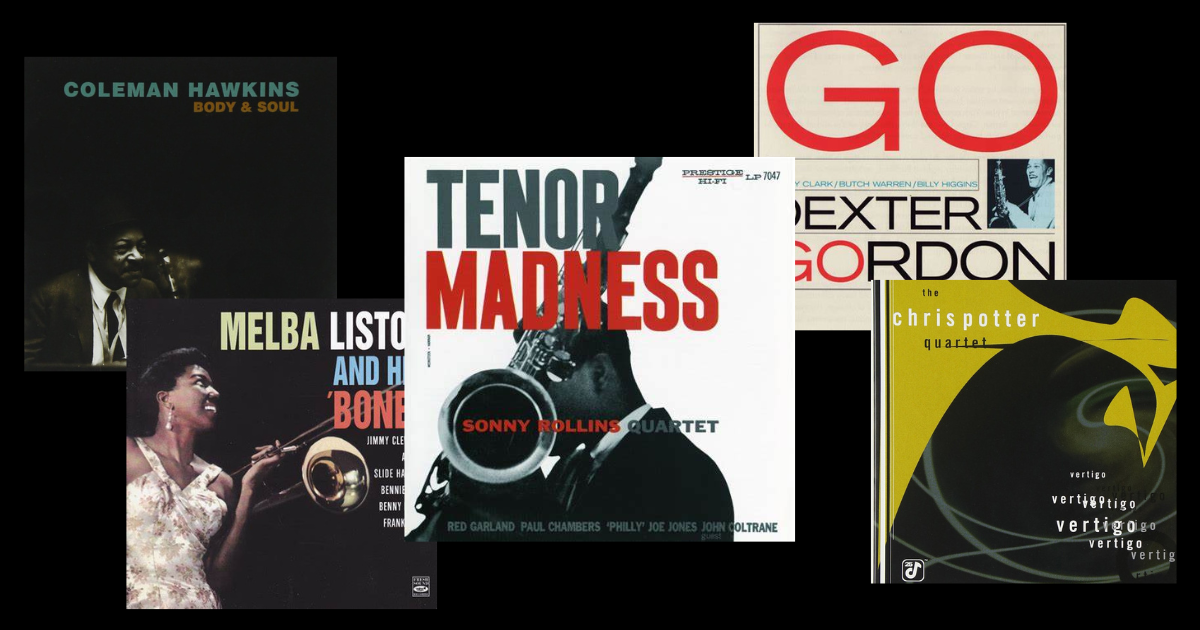
A History of the Tenor Saxophone
 A brief tribute to the Tenor Saxophone, written by Dr. Kelsey Klotz, Musicologist and lecturer in UNC Charlotte’s Department of Music, and JazzArts Charlotte instructor for the favorite virtual “Jazz Appreciation” series.
A brief tribute to the Tenor Saxophone, written by Dr. Kelsey Klotz, Musicologist and lecturer in UNC Charlotte’s Department of Music, and JazzArts Charlotte instructor for the favorite virtual “Jazz Appreciation” series.
August 2022 — It’s fitting that we take some time this month to appreciate the tenor saxophone, an instrument that has featured prominently throughout the history of jazz. The saxophone family includes up to 9 members of varying high and low ranges. The most common saxophones are the Soprano, Alto, Tenor, and Baritone, all of which are used in jazz. As jazz was gaining prominence in the late 1910s, ensembles tended to feature the clarinet, trumpet, and trombone, along with rhythm section instruments like the guitar, piano, drums, and tuba (which was eventually replaced by the bass). By the 1920s, saxophones had gained prominence around the country through touring military and brass bands. Around 1925, the alto and tenor saxophones became a prominent feature of Kansas City jazz; Coleman Hawkins (tenor), Lester Young (tenor), Charlie Parker (alto), and Ben Webster (tenor) are just a few of the best known saxophonists to come out of Kansas City in the 1930s.
Together, Coleman Hawkins and Lester Young especially cemented the tenor saxophone’s importance and popularity in jazz by offering two distinct models. Hawkins’s most well-known record, “Body and Soul” (1939), is a perfect representative of his musical style: virtuosic, with a warm timbre (or sound) and quick vibrato (fluctuations in pitch). In his solos, Hawkins develops short melodic phrases with a keen ear toward complex harmonies. “Body and Soul” gestures toward bebop several years before the genre was developed. Lester Young, on the other hand, is often considered a progenitor of the cool jazz genre: he emphasized melodies and phrasing, and his 1930s and 1940s timbre is lighter and more relaxed (though no less intense) than Hawkins’s. “Lady Be Good” (1936) is a good example of Young’s approach.
Since then, the tenor saxophone tradition in jazz has only expanded, spanning the gamut from Stan Getz (1927-1991, cool jazz and bossa nova), to Dexter Gordon (1923-1990, bebop and hard bop), to Joshua Redman (b. 1969), Chris Potter (b. 1971), and Melissa Aldana (b. 1988). But there are two others who stand out: Sonny Rollins (b. 1930) and John Coltrane (1926-1967), whose 1956 recording “Tenor Madness” inspired the title for this event.
Sonny Rollins led the recording date. He had previously worked with trumpeter Miles Davis, who was already well-known in the jazz world. Rollins had recorded his compositions “Oleo,” “Airegin,” and “Doxy” on the 1954 Davis album Bags’ Groove (these tunes have since become key songs in the jazz repertoire). On Tenor Madness, recorded after Rollins left the Davis Quintet, Rollins appears with the Davis rhythm section (Red Garland, piano; Paul Chambers, bass; Philly Joe Jones, drums). The title track, originally “Royal Roost” and renamed “Tenor Madness” for this album, featured John Coltrane alongside Rollins. Coltrane had recently joined the Davis Quintet in Rollins’s place. This title track has since become jazz canon, because it is the only time these two tenor saxophone greats were recorded together. Put together with the marketing—“tenor madness”—and we have the makings of a legendary track.
It is somewhat unusual for soloists playing the same instrument to be featured like this—doing so risks undermining the leader, Rollins, because audiences might become confused as to who is playing when. But even by 1956, both Rollins and Coltrane had developed unique sounds and approaches to playing. Even if listeners don’t immediately know which sound is which, they can still mostly track the conversation between the two tenors—but the liner notes also provide some assistance, letting the audience know that Coltrane takes the first solo.
Something else that is unusual about this track is its attitude: listeners might expect a competitive edge between two tenor saxophonists so close in age. But “Tenor Madness” isn’t a cutting contest, or a musical battle in which jazz musicians try to best one another. “Tenor Madness” is a blowing session, when musicians play together, improvising and trading ideas in an informal way (its over 12 minutes also defuse that tension—everybody has room to play!). Ultimately, it feels like a joyous exploration and exchange of ideas, allowing listeners to revel in the sounds and the interaction between two men that seem to enjoy playing together.
“Tenor Madness” has a 12-bar blues form, which means that there is a 12 measure chord progression that repeats throughout the song (that chord progression gets repeated about 45 times in the course of the recording). It begins as many jazz tunes begin, with Rollins and Coltrane playing the head (the composed melody). They get that out of the way quickly, spending only one chorus on it and immediately jumping into Coltrane’s improvised solo. Coltrane’s seven-chorus solo is an early Coltrane-style, which is pre-“sheets of sound”—a dense improvisational style featuring high speed patterns spanning the full range of his instrument (check out “Giant Steps”, in which Coltrane established this approach). There are plenty of fast notes, but none of the patterns and overwhelm that characterize his late 1950s work. Coltrane’s sound here is bright, boisterous, and even strident at times. Rollins enters at 2:11 for an eight-chorus solo, and immediately presents a different approach to the tenor. His sound is smooth, full, and assertive. He has a longer sense of phrasing than Coltrane here. After solos for Garland (piano) and Chambers (bass), Coltrane and Rollins return to trade fours with Jones (drums) at 6:18. Trading fours means that each instrumentalist—Coltrane, Rollins, and Jones—takes turns improvising over four measures. Any members of the band can trade fours, but it’s often done as a way to feature the drummer.
In many jazz combo performances, trading fours leads into the final chorus, in which the band members play the head again and finish the song. However, “Tenor Madness” gives us more choruses with Coltrane and Rollins: Coltrane takes another two chorus solo at 7:23, and Rollins takes two choruses at 7:57. At 8:30, Coltrane and Rollins begin to trade fours for about twelve choruses, until the final head melody concludes the song. It’s in this final section in which Coltrane and Rollins trade fours that the blowing session takes over—this section doesn’t necessarily lack urgency, but we hear both Coltrane and Rollins trying out different short ideas, picking something up from the other, or going in a completely new direction. Sometimes they mimic or develop a rhythmic idea, sometimes a melodic pattern or idea, but they rarely blow over each other. This is also the part of the song where it’s easiest to lose track of which saxophonist plays when: my advice is to return to the earlier solos and practice naming how each saxophonist sounds different. For me, I can always hear Rollins’s entry as more confident and fuller, whereas Coltrane sounds lighter here.
It’s a special thing when performers who play the same instrument get to improvise together—another example I love is Melba Liston and Her ‘Bones, 1958. JazzArts Charlotte hopes you enjoy Tenor Madness, featuring tenor saxophonists Chelsea Baratz, Stacy Dillard, Tommy Morimoto, and Brice Winston, and rhythm section Kobie Watkins (drums), Shannon Hoover (bass), and Kevin Bales (piano), August 12 at the Jazz Room.